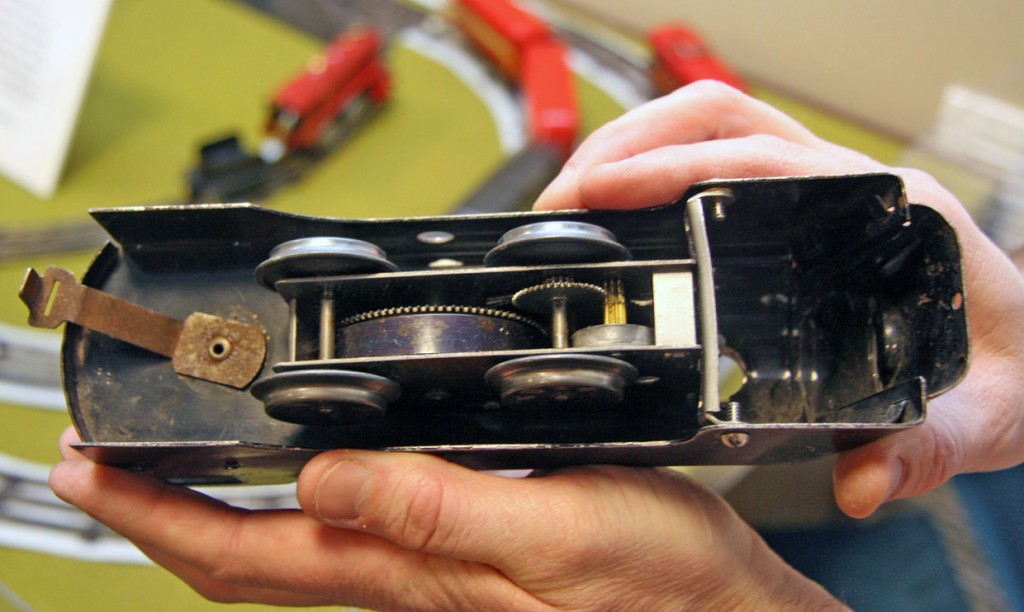Missouri collector all wound up over trains that were once the toy/model railroading norm
May 4, 2013 / Updated May 13, 2013
 Model Railroading
Model Railroading
James Pekarek joked that his hands and wrist would probably need medical attention. Every few minutes, he turned the key and wound vintage locomotives that pulled a handful of cars around a couple of loops of track. When the trains stopped, another quick wind revved them up again.
The trains, on display at March’s Ozarks Model Railroad Association spring train show in Springfield, MO., offered a glimpse of early-day model railroading that didn’t require the then-luxury of electricity.
“I got my first train set when I was 2½ years old,” said the Strafford, MO, resident, who also dabbles in 12-gauge railroading (a hand-built Frisco caboose flanked the windup display). “These are kind of a forgotten thing, and I like them because they represent basic fun. I like to buy them and fix them up.”
Pekarek, 43, estimates that he has about seven dozen locomotives. He relished a find at the show, a windup that only needed a new running gear. He paid just a few bucks for it.
Marklin and Joy Line were among early makers of windup trains, sometimes called clockwork trains that date to the 1800s. A series of gears and springs turn wheels under tension after being wound like a timepiece. Depending on the mechanism, each wind from the key creates 65 revolutions from the wheels.
Marx became a major player in the windup world after purchasing Joy Line in 1934 to provide a quality, low-cost alternative to toy trains marketed by Lionel and American Flyer. Like the Joy Line trains, the first Marx trains were key-wound and made from inexpensive tin. Locomotives and cars sported lithographed logos (New York Central was popular), and an early five-piece set without track sold for $2.
“It’s amazing that you get people who come through here and say, ‘I’ve never seen anything wind up,’ ” Pekarek said.
More on this story in the May/June 2013 issue of Cowcatcher Magazine!

Photos by Tim Blackwell/Cowcatcher Magazine



Growing up in Central Texas in the 1980s, David Heyde loved big machinery. Only natural for a boy surrounded by a mighty river complemented by steamboats, an active Army airfield and regional airport, and equipment that tended row upon row of corn, soybeans and other grains. What loomed largest, though, was the Missouri-Kansas-Texas Railroad. Heyde’s MKT Central Texas Subdivision, a compact but bold HO-scale layout, captures on two levels around the walls the zest of the iconic railroad that ran from Kansas City and St. Louis to Galveston, TX, and the Gulf of Mexico. All while maximizing space in what once was a one-car garage.
This year’s National Narrow Gauge Convention is coming home, where it all began 45 years ago. The Mudhens will once again have a large presence at the convention Sept. 3-6 in St. Louis. Over the last four decades, their rise has been rather circuitous. While developing national appeal in narrow-gauge circles, these dedicated modelers from St. Louis to Arizona to Texas have persevered.
The Kansas City West Bottoms Railroad (KCRR) debuted in early March, with no small impact on a parcel of track along the former Missouri Pacific Railroad near the Kansas-Missouri line. What’s turning heads, says KCRR president Rich Duncan, is that the tiny Class III short line is rewriting the railroad marketing narrative on first-mile, last-mile service with a new level of dedicated switching so its three customers can better connect to the Union Pacific.
Columnist Michelle Kempema writes that model railroaders and railfans can preserve their legacy for a good cause, railroads once ran special trains in enormous size and variety and autonomous battery-electric rail cars are being piloted on two Georgia short line railroads. Also, one modeler looking for something unique for his layout found just the thing in an old model railroad magazine - plans to scratch build a rock bunker. And more!